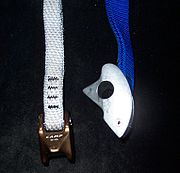
Tricam
Encyclopedia

The most versatile nut, the Tri-cam, was invented by Greg Lowe in 1973, and came to market in 1981.
Design
It is a passive or active device consisting of a shaped aluminiumAluminium
Aluminium or aluminum is a silvery white member of the boron group of chemical elements. It has the symbol Al, and its atomic number is 13. It is not soluble in water under normal circumstances....
piece attached to a length of webbing
Webbing
Webbing is a strong fabric woven as a flat strip or tube of varying width and fibres often used in place of rope. The name webbing comes from the meshed material frequently used in its construction, which resembles a web...
tape or wire cable. The device is designed to be inserted into a crack so that pulling on the tape or wire makes the piece cam outward against the sides of the crack, gripping the rock tighter. This camming action is achieved by the position of the pointed fulcrum of the piece relative to the attachment of the tape or wire. As the webbing or wire is pulled, the downward force is pivoted onto the point, which can bite into soft rock or ice and increases the holding power of the tricam.
Benefits
Tricams are generally not as easy to place or remove as spring-loaded camming devices (SLCDs) but are much cheaper, lighter, and have some of the highest breaking strengths out of all rock climbing protection devices. Unlike SLCDs they are less likely to fail in the alpine environment as they have no moving parts to freeze, making them an excellent choice for a mountaineer's rack. They typically work best on sandstone or limestone as the fulcrum is more likely to bite into the soft rock.They can also be used passively as nut
Nut (climbing)
In rock climbing, a nut is a metal wedge threaded on a wire, used for protection by wedging it into a crack in the rock. Quickdraws are clipped to the nut wire by the ascending climber and the rope threads through the quickdraw. Nuts come in a variety of sizes and styles, and several different...
s.
Drawbacks
Placing a tricam is relatively simple but takes practice to achieve proficiency. Care must be taken so that the tricam does not loosen while climbing above its placement due to rope drag. Typically, this additional safety is provided by clipping a longer sling to the tricam. In addition to this weakness tricams can also exhibit welding characteristics after being subjected to a hard fall making them harder to clean and more likely to be left behind.Specifications
Tricams are available in a range of sizes to suit cracks from 10–140 mm wide. They are especially useful in horizontal cracks, quarryQuarry
A quarry is a type of open-pit mine from which rock or minerals are extracted. Quarries are generally used for extracting building materials, such as dimension stone, construction aggregate, riprap, sand, and gravel. They are often collocated with concrete and asphalt plants due to the requirement...
drill holes, and limestone
Limestone
Limestone is a sedimentary rock composed largely of the minerals calcite and aragonite, which are different crystal forms of calcium carbonate . Many limestones are composed from skeletal fragments of marine organisms such as coral or foraminifera....
pockets, where they may be the only type of protection that works. The smallest size can also work well in old piton
Piton
In climbing, a piton is a metal spike that is driven into a crack or seam in the rock with a hammer, and which acts as an anchor to protect the climber against the consequences of a fall, or to assist progress in aid climbing...
scars.
As manufactured they come in size numbers 0.125 to 7, with strength 2–22 kN, width 10–140 mm, and weight 9–264 g.

